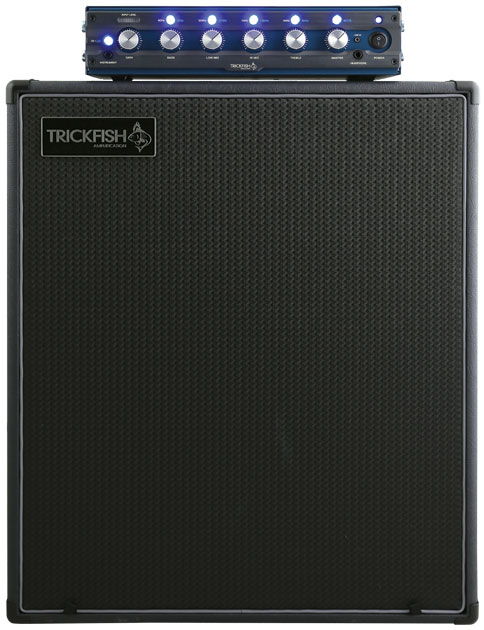 When bassists learned that player/designer Mike Pope was behind the preamp section of the Trickfish Bullhead 1K, they were giddy with anticipation. For this review we paired the amp with the company’s Big Mouth BM 212 cabinet. (Trickfish offers other compatible cabs, including ones from their compact Small Mouth series.)
When bassists learned that player/designer Mike Pope was behind the preamp section of the Trickfish Bullhead 1K, they were giddy with anticipation. For this review we paired the amp with the company’s Big Mouth BM 212 cabinet. (Trickfish offers other compatible cabs, including ones from their compact Small Mouth series.)
Bottom Dwellers The Bullhead 1K’s power section consists of a class-D amplifier rated at 1,000 watts peak. Designed to highlight a bass’s inherent sound, the preamp boasts a user-friendly EQ section. The gain section includes a hi/low button to optimize an instrument’s pickups. You monitor the gain via a ten-segment LED “ladder” that works with the attenuator to prevent clipping. A cool-blue aluminum chassis protects the components. Everything weighs in at a manageable 6.2 pounds.

The EQ goes beyond a basic 4-knob configuration: color-coded buttons above the knobs set specific frequency centers. For example, the bass control is a shelving-type EQ. When its corresponding button shines blue, all frequencies below 80 Hz (labeled in blue) are affected. When the light is off, the shelving frequency is 40 Hz (labeled in white).
The treble section offers a similar choice of shelving frequencies (4 kHz or 8 kHz). Low-mid and hi-mid are band-pass filters that can be centered at 333 Hz or 473 Hz and 1 kHz or 1.8 kHz, respectively. TRICKFISH BULLHEAD 1K AMP Pros: User-friendly preamp. Solid power. Clean tone. Great input-level indicator.
Cons: Frequency buttons might not be durable.
Tones:
Ease of Use:
Build/Design:
Value:
Street: $1,249 TRICKFISH BIG MOUTH BM 212 Pros: Responsive cabinet with present mids.
Cons: A hefty 68 pounds despite the neo drivers. Pricy.
Tones:
Versatility:
Build/Design:
Value:
Street: $1,199
trickfishamps.com There are many other beneficial features. On the front panel, a 1/4" stereo jack permits isolated listening, while an 1/8" jack provides an aux input. The rear panel offers an effects loop, tuner out, DI, and combo connectors for Speakon or 1/4" plugs.
The BM 212 is a front-ported cabinet constructed of Baltic birch using dado and rabbet joints. Inside are two Eminence 12" neodymium speakers and a high-frequency driver. Metal handles and corners provide protection in transit, and the beefy cabinet is wrapped in sharkskin vinyl.
Fish On As soon as the Trickfish duo arrived, it went straight onstage for an outdoor gig in 90-degree weather and high humidity. My basses were a La Bella Olinto PJ and a Fender Marcus Miller 5-string Jazz.
Be warned: When the Bullhead begins its power-up sequence, you might draw the attention of low-flying planes. The frequency buttons flash bright blue, bookended by the beaming input and mute buttons.
The rig’s tone is warm and refined, and the input-level meter made gain setting a breeze. The frequency buttons didn’t feel quite as robust as the large, sturdy knobs, though I encountered no problems. The EQ was ridiculously easy to use, with plenty of boost/cut range at each frequency. When I needed to tweak my tone, the EQ made quick work of it. For example, a low-mid boost at 473 Hz and a bass boost at 80 Hz gave the Olinto added warmth and punch. I swiftly crafted a slap-friendly sound with a slight cut at 1.8 kHz and a boost at 8 kHz.
The next day I used the rig at another outdoor venue, where temperatures had dropped into the mid 40s. The Bullhead didn’t flinch. The rig transmitted 16th-note lines with authority, from punchy P-style passages à la Rocco Prestia to Jaco-esque aggression. The rig didn’t deliver quite enough stage volume to hold its own against a Fender Twin Reverb and a hard-hitting drummer, but I could comfortably hear my sound.
To hear how the components functioned separately, I took a Sadowsky Will Lee 4-string to a jam night, where I combined the Bullhead 1K and BM 212 with amps and 2x12 cabs from three different manufacturers. The Bullhead 1K shined with every cab, delivering detail, versatility, and a supportive punch across the fretboard. While I used significant EQ adjustments when the 1k was paired with the BM 212, I found that I could leave the EQ nearly flat when matching the head with other cabs. With its forward mids and open-sounding low end, the BM 212 may lack the clarity and girth of some other cabs in its class, but its voice will likely please those who prefer vintage-style timbres.
The Verdict This is an impressive rig with excellent EQ. Unlike some boutique equivalents, it doesn’t hype lows and highs to convey clarity—it simply has a full, balanced sound. Time will tell how roadworthy the rig is, but the way it handled extreme temperatures was a positive sign. If you seek amplification that gets close to studio-quality transparency, consider casting your attention towards Trickfish.
